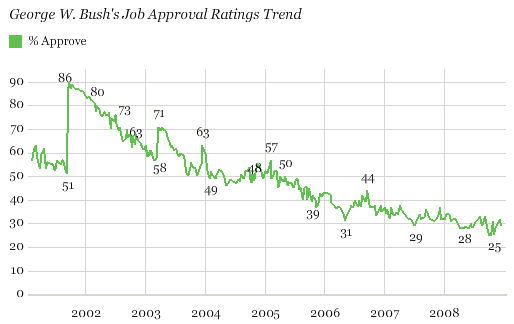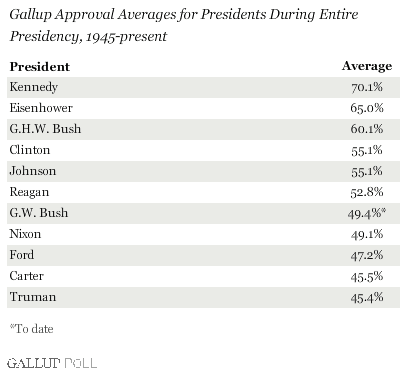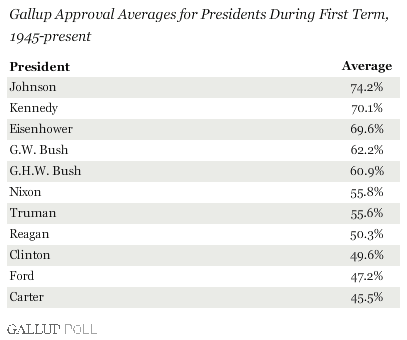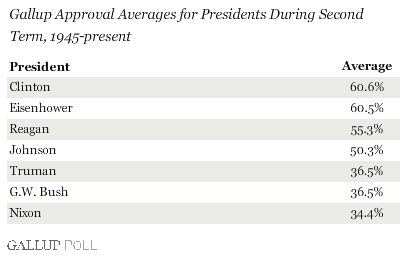PRINCETON, NJ -- Extreme highs and lows have characterized George W. Bush's job approval ratings as president. His record 90% approval rating early in his presidency following the Sept. 11 terrorist attacks stands in stark contrast to his sub-30% approval ratings during most of his final year in office, which rank among the lowest ratings ever measured.

Because of these ups and downs, Bush's 49% approval average for his presidency will rank him in the middle of the pack (7th of 11) of post-World War II presidents. His average to-date of 49.4% is similar to Richard Nixon's 49.1% but slightly better than Harry Truman's and Jimmy Carter's historical lows below 46%.
John Kennedy's 70.1% average for his brief two-and-a-half year term rates as the highest. Bush's father averaged 60.1% during his one-term presidency.

Bush's Solid First Term
Bush's first term may be remembered most for the several "rallies" in public support for him in response to international crises.
The 35-percentage-point increase in Bush's approval rating following the Sept. 11 terrorist attacks is the largest "rally" in public support for a president in polling history. Just before the attacks occurred, 51% of Americans approved of the job he was doing as the president. By the end of that week, 86% did. In subsequent days, his rating inched up further to 90%, the highest Gallup has ever measured for a president.
That rally in support showed remarkable staying power, and Bush's approval rating remained above 80% for nearly 6 months and above 70% for 10 months. He remained popular with a 63% approval rating at the time of the 2002 elections, helping Republicans to achieve rare Congressional seat gains in a midterm election year.
In late 2002 and early 2003, the United States and its allies were contemplating military action in Iraq to remove Saddam Hussein from power. During this time, Bush's approval rating held in the low 60s and high 50s. But in response to the March 19 invasion, Bush received a second major rally in public support, seeing his rating jump from 58% to 71%. That 13-point increase is among the five highest rallies Gallup has measured for a president since World War II.
The 71% rating would be as high as Bush's approval rating would get after that, though he received a third significant rally in support (from 56% to 63%) in December 2003 after the United States captured Saddam Hussein.
Bush began his re-election year of 2004 with a strong 60% approval rating, but that quickly dipped to 49% as the Democratic presidential nomination campaign focused media attention on the opposition's criticism of the incumbent president. Bush spent most of his re-election year around the 50% mark -- a significant number since it has generally been an indicator of re-election success. Ultimately, Bush won re-election in a closely fought contest with an approval rating of 48%.
During his first term, Bush had an average 62.2% approval rating. That ranks as the fourth best first term average approval rating among post-World War II presidents, behind Lyndon Johnson, Kennedy, and Dwight Eisenhower, and just ahead of his father, the elder George Bush.

Second-Term Blues
Following his re-election, Bush's support went back above the majority level, reaching 57% in early February 2005 after Iraq held successful elections. That turned out to be the high point for Bush's second term, as the Bush administration had difficulty responding to mounting difficulties in Iraq and the devastating effects of Hurricane Katrina. By September 2005, his approval rating dipped to 40%, and fell below that mark after his ill-fated attempt to nominate White House counsel Harriet Miers to the Supreme Court.
Bush's troubles continued to mount in 2006, as the Iraq war dragged on, gas prices climbed, and the government was unable to agree on legislation to address illegal immigration. In May 2006, just 31% of Americans approved of the job Bush was doing, a new low for his presidency.
Bush's popularity recovered somewhat in subsequent months as gas prices stabilized, and reached 44% as Americans recognized the fifth anniversary of the Sept. 11 terrorist attacks. That would be the last time Bush's approval rating exceeded 40%. His greater than two-year string of sub-40% approval ratings is the longest for any president since the advent of polling. Bush's growing unpopularity surely helped Democrats gain control of Congress in the 2006 midterm elections for the first time since 1994.
Bush's approval rating fell below 30% in July 2007 as gas prices once again reached high levels. Bush's final year in office was marked by ratings around 30%, including a new low of 25% in the days after Congress passed controversial legislation to bail out major financial institutions. Bush matched that term low of 25% approval in the final 2008 pre-election poll, as Barack Obama was elected his successor and Democrats made further gains in the House and Senate.
Toward the end of his presidency, the bulk of Bush's limited public support came from Republicans, in particular conservative Republicans.
With just a couple weeks left in his second term, Bush has averaged only 36.5% approval since the term began in January 2005. Bush's weak second term is tied with Truman's, and only slightly better than what Nixon got leading up to his resignation from office. Bill Clinton and Eisenhower had the highest second term averages.

The Bush Presidency
Some of the highest high and lowest low approval ratings for a president have characterized Bush's presidency. In many ways, it is similar to Truman's presidency. Truman entered office with very high approval ratings following Franklin Roosevelt's death and U.S. victory in World War II. That popularity faded by the time Truman was up for re-election in 1948, but he managed an unexpected victory. The ongoing war in Korea and a poor economy made Truman very unpopular for much of his second term, including an all-time low approval rating of 22% in 1952. Truman and Bush were replaced by popular presidents from the opposition party.
President Bush, first lady Laura Bush, and others have tried to downplay the president's low approval ratings by arguing that history may judge his presidency more favorably. Only time will tell whether that will in fact happen, but it is true that average approval ratings do not necessarily correlate with how people judge presidents in retrospect. For example, the public generally regard Nixon as one of the worst presidents, even though other presidents have had lower approval rating averages while in office. And people generally view Ronald Reagan as one of the better recent presidents despite a rather mediocre 53% average approval rating during his presidency.
Survey Methods
Results are based on telephone interviews with approximately 1,000 national adults, aged 18 and older, conducted at various times in 2001-2008. For results based on each separate sample of national adults, one can say with 95% confidence that the maximum margin of sampling error is ±3 percentage points.
In addition to sampling error, question wording and practical difficulties in conducting surveys can introduce error or bias into the findings of public opinion polls.
